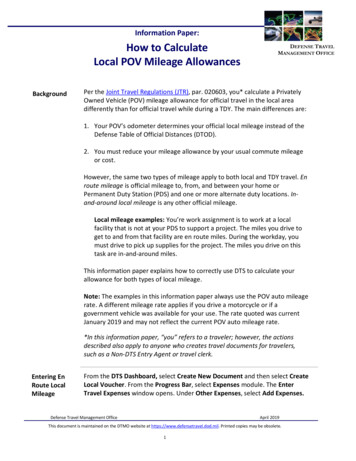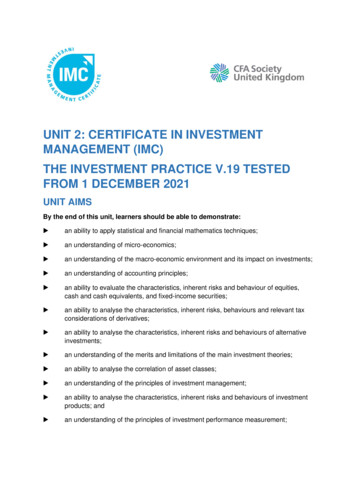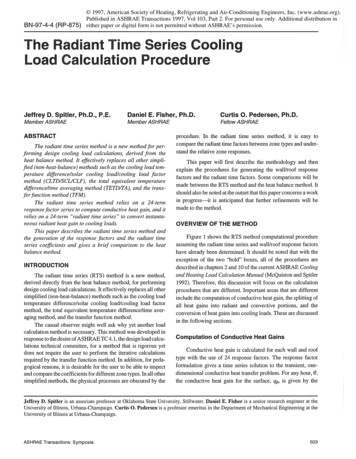
Transcription
Information Paper:How to CalculateLocal POV Mileage AllowancesBackgroundDEFENSE TRAVELMANAGEMENT OFFICEPer the Joint Travel Regulations (JTR), par. 020603, you* calculate a PrivatelyOwned Vehicle (POV) mileage allowance for official travel in the local areadifferently than for official travel while during a TDY. The main differences are:1. Your POV’s odometer determines your official local mileage instead of theDefense Table of Official Distances (DTOD).2. You must reduce your mileage allowance by your usual commute mileageor cost.However, the same two types of mileage apply to both local and TDY travel. Enroute mileage is official mileage to, from, and between your home orPermanent Duty Station (PDS) and one or more alternate duty locations. Inand-around local mileage is any other official mileage.Local mileage examples: You’re work assignment is to work at a localfacility that is not at your PDS to support a project. The miles you drive toget to and from that facility are en route miles. During the workday, youmust drive to pick up supplies for the project. The miles you drive on thistask are in-and-around miles.This information paper explains how to correctly use DTS to calculate yourallowance for both types of local mileage.Note: The examples in this information paper always use the POV auto mileagerate. A different mileage rate applies if you drive a motorcycle or if agovernment vehicle was available for your use. The rate quoted was currentJanuary 2019 and may not reflect the current POV auto mileage rate.*In this information paper, “you” refers to a traveler; however, the actionsdescribed also apply to anyone who creates travel documents for travelers,such as a Non-DTS Entry Agent or travel clerk.Entering EnRoute LocalMileageFrom the DTS Dashboard, select Create New Document and then select CreateLocal Voucher. From the Progress Bar, select Expenses module. The EnterTravel Expenses window opens. Under Other Expenses, select Add Expenses.Defense Travel Management OfficeApril 2019This document is maintained on the DTMO website at https://www.defensetravel.dod.mil. Printed copies may be obsolete.1
DEFENSE TRAVELMANAGEMENT OFFICEEntering EnRoute LocalMileage(continued)If you drove your POV from your home or PDS directly to, from, or betweenalternate duty locations in your local area:1. Use the vehicle’s odometer to determine your official one-way mileage.2. An Expense Category screen displays the four primary categories orgroupings of International Travel Expenses, Other Expenses, MileageExpenses, and Transportation Expenses.3. Select Mileage Expenses, select a mileage type:a. Use Private Auto – Local Area or Private Motorcycle – Local Areaoption if the Authorizing Official (AO) approved you to drive yourautomobile or motorcycle.b. Use Private Vehicle – GOV Auth & Avail option if you chose to driveyour POV even though the AO approved you to use a Governmentvehicle. Note: DTS sometimes uses “privately owned conveyance”(POC) where the JTR uses “POV.”4. Enter the Expense Date, Purpose, the place you departed From, the placeyou drove To, number of one-way Miles you drove on that leg of the trip,and the Method of Reimbursement.5. If you indicate that you drove From or To your Residence, additionaloptions appear (see examples below). Select whether you normally drive orincur a cost to commute, and the applicable mileage or cost.6. Check the create a separate expense for round-trip box to duplicate thecalculated allowance for the return trip, creating the round-trip total.7. Select Add Expense.DTS calculates your mileage allowances as follows:Defense Travel Management OfficeApril 2019This document is maintained on the DTMO website at https://www.defensetravel.dod.mil. Printed copies may be obsolete.2
DEFENSE TRAVELMANAGEMENT OFFICEEntering EnRoute LocalMileage(continued)If you normally drive to work: DTS subtracts the number of one-way miles you usuallycommute (entered in step 4 on previous page) before multiplying by the mileage rate.Example: You normally drive 5 miles one-way to and from work. Today, you drove fromhome to an alternate work location 12 miles away. At the end of the day, you drovedirectly home.12 miles (to alternate duty location) – 5 miles (normal commute) 7 miles7 miles x 0.58/mile (mileage rate) 4.06 (one-way mileage allowance) 4.06 x 2 (to create a round-trip) 8.12 (round-trip mileage allowance)If you normally take public transportation: DTS calculates your mileage allowance based onthe total number of one-way miles driven, and then subtracts the cost of your normal one-waycommute (entered in step 4 on previous page).Example: You normally pay 5.00 one-way to take the subway to and from work. Today,you drove your car to an alternate work location 20 miles from your home. At the end ofthe day, you drove directly home again.20 miles (to alternate duty location) x 0.58/mile (mileage rate) 11.60 11.60 - 5.00 (normal commuting cost) 6.60 (one-way mileage allowance) 6.60 x 2 (to create a round-trip) 13.20 (round-trip mileage allowance)Note: For either of the above calculations, if the resulting mileage allowance is a negativenumber (e.g., you drove fewer miles to the alternate work site than you normally drive to yourPDS), you will not receive a mileage allowance.If your official duties took you to multiple locations on the same day, follow thesame steps listed above, except:1. In step 3, enter your total (vs. one-way) official mileage for the day.2. In step 4, enter your usual round-trip (vs. one-way) commute mileage orcost.3. Skip step 5; don’t check the round-trip box.Defense Travel Management OfficeApril 2019This document is maintained on the DTMO website at https://www.defensetravel.dod.mil. Printed copies may be obsolete.3
DEFENSE TRAVELMANAGEMENT OFFICEEntering EnRoute LocalMileage(continued)Example: You live 20 miles from work (40 miles round trip). Today, you drove your car 22miles to one alternate work location, then 18 miles to a second alternate work location, andfinally 15 miles back to your home.22 miles 18 miles 15 miles 55 miles (total miles driven for the day)55 miles – 40 miles (normal round-trip commute miles) 15 miles15 miles x 0.535/mile (mileage rate) 8.03DTS local voucher entry by Tim, who normally pays 5.00/day (Figure 1,Indicator 1) to commute to or from work. On this day, Tim drove his own car20 miles (Figure 1, Indicator 2) from home to an alternate duty location. At theend of the day, he returned home from that location (same mileage). Noticethat Tim entered one-way information, but checked the round trip box (Figure1, Indicator 3) to create a matching mileage allowance for his return trip.123xFigure 1: Entering Local Mileage in DTSEntering Inand-AroundMileageIf you accrue official mileage that is not to, from, or between your home or PDSand one or more alternate duty locations, you must claim it as in-and-aroundDefense Travel Management OfficeApril 2019This document is maintained on the DTMO website at https://www.defensetravel.dod.mil. Printed copies may be obsolete.4
DEFENSE TRAVELMANAGEMENT OFFICEmileage using either private auto or motorcycle. Always enter in-and-aroundmileage and en route mileage as separate allowances – don’t combine them.To calculate an in-and-around miles use Private Auto - Local Area or PrivateMotorcycle - Local Area mileage allowance:1. Use the vehicle’s odometer to determine your official one-way mileage.2. From the Progress Bar, select Expenses module. The Enter Travel Expenseswindow opens. Under Other Expenses, select Add Expenses.3. The Expense Type window opens displaying the Expense Categories, selectMileage Expenses, and then select Private Auto - Local Area option (Figure2).4. Enter the Expense Date, Purpose, From and To Locations, and the totalnumber of in-and-around Miles (driven for this travel), and Method ofReimbursement.5. Select Add Expense.Figure 2 displays Jamie’s local voucher mileage entry. The example shows her22-mile round trip (Figure 2, Indicator 1) to get to the Pentagon and backagain. Jamie determined the mileage using the vehicle’s odometer.Defense Travel Management OfficeApril 2019This document is maintained on the DTMO website at https://www.defensetravel.dod.mil. Printed copies may be obsolete.5
DEFENSE TRAVELMANAGEMENT OFFICEEntering Inand-AroundMileage(continued)1Figure 2: Entering Mileage Private Auto - Local Area6. The mileage details display under Other Expenses (Figure 3).Figure 3: Mileage Details – Other Expenses ScreenReferencesFor additional information about how to calculate local mileage, refer to theJTR.For more information on local vouchers, refer to the Create a Local Vouchertrifold or DTS Guide 4: Local Vouchers.Defense Travel Management OfficeApril 2019This document is maintained on the DTMO website at https://www.defensetravel.dod.mil. Printed copies may be obsolete.6
7 miles x 0.58/mile (mileage rate) 4.06 (one-way mileage allowance) 4.06 x 2 (to create a round-trip) 8.12 (round-trip mileage allowance) If you normally take public transportation: DTS calculates your mileage allowance based on the total number of one-way miles driven, and then subtracts the cost of your normal one-way











